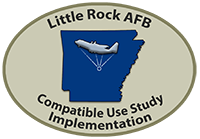Compatible Use Studies are similar to other planning processes our local communities regularly engage in. There typically are three general phases:
- The planning process, which assesses needs and identifies recommendations to address those needs,
and results in a Compatible Use Study report;
- Development of implementation tools recommended in the Compatible Use Study report; and
- Adoption and implementation of those tools by local agencies and stakeholders, the base, and local government.
In Phase II, a “CUS Implementation Committee,” will work with the Consultant Team to develop the highest-priority recommendations described in the Little Rock CUS report (January 2021), including preparation of implementing documents, ordinances, agreements, land use plan policies, and the like.In the third phase, the tools developed in Phase II are presented to implementing agencies (e.g., local governments, state agencies, and Little Rock AFB) for adoption and application. This third phase is similar in nature to the implementation of a zoning ordinance or inter-local agreement after adoption or execution.
The CUS Implementation project will occur over a 15 to 18-month timeframe and will result in between 15 and 20 separate deliverables, which may include:
Memorandum of Understanding (MOU) & Legislative Clarifications & Mapping
Includes an MOU for regional coordination with Little Rock AFB and the preparation of legislative/statutory revisions to clarify scope of local government authorities.
Updated Jurisdictional Maps
This project also will include development of updated jurisdictional maps of the region, which clarify the scope of local planning, zoning, and subdivision jurisdictions, including where applicable, extraterritorial jurisdiction.
Regulatory and Non-Regulatory Drafting
Includes the preparation of Air Installation Compatible Use Zone (AICUZ) Overlay regulations and updates to existing regulations. Some jurisdictions that do not have zoning may elect to use non-regulatory standards to encourage land use and development that is compatible with military operations and LRAFB and the surrounding installations. Important areas for the Committee to consider in this regard include building and structure height and potential interference with air operations by civilian land uses.
Military Planning and Coordination Committee
A standing “Military Planning and Coordination Committee” made up of local military and community members will be created to facilitate ongoing coordination between Little Rock Air Force Base and the civilian and local government communities. A website will be set up and maintained by the MPCC and housed on the City of Jacksonville website.
MOU and Regulatory
Includes facilitation of Little Rock AFB input prior to local approvals of new growth-inducing infrastructure, review of military impact during consideration of annexation applications, and establishes a standing Military Planning and Coordination Committee (MPCC).
Planning
Includes the preparation of small area plans and updates to existing comprehensive plans and other policy and planning documents to reflect CUS findings and recommendations.
Public Outreach and Interagency Coordination
Includes periodic Little Rock AFB updates to local governments and the public, preparation of public outreach materials, and setting up the MPCC website. The Implementation Committee also will consider distribution of outreach materials and awareness documents related to property owner/applicant/purchaser awareness of military impacts that could affect their property and, conversely, civilian activities that should be avoided so as not to impair military operations; for example, use of unmanned aerial vehicles (or “drones”) in proximity to military installations and operations.
